Search Thermo Fisher Scientific
Quattro Environmental Scanning Electron Microscope
The Thermo Scientific Quattro ESEM combines all-around performance in imaging and analytics with a unique environmental mode (ESEM) that allows samples to be studied in their natural state. It is ideal for a wide variety of academic, industrial, and government labs that want the versatility and ease of use needed for multiple users of different experience levels and disciplines on a platform that also supports unique in situ experiments. The Quattro ESEM features a field emission gun (FEG), which ensures excellent resolution. Meanwhile, its three vacuum modes (high vacuum, low vacuum, and ESEM) provide the flexibility to accommodate the widest range of samples of any SEM available, including those that are outgassing or otherwise not vacuum-compatible.

Learn more about this product in our on-demand webinar
Discover how to analyze liquids and hydrated samples in 3D using environmental scanning electron microscopy.
Best in class for in situ imaging capabilities, dynamic experiments with excellent analytical capabilities
The Quattro ESEM is a highly flexible platform for in situ dynamic experiments. The Quattro ESEM's environmental SEM capability allows scientists to study materials in a range of conditions, such as wet/humid, hot, or reactive environments, as they develop new materials and products. It supports cooling and heating experiments both in high vacuum and low vacuum to accommodate the widest range of needs. Cooling experiments on wet materials are possible with the Peltier cooling stage or if the transmission mode is needed, with Thermo Scientific WetSTEM Technology. Additionally, the Quattro ESEM provides several different possibilities to heat the samples of interest, both bulk and powders. Users can perform dynamic experiments at high temperatures both in high vacuum (with the high-vacuum heating stage), in low-vacuum/ESEM mode (with the two ESEM heating stages for temperatures up to 1,000°C and 1,400°C), and on a localized area for better control of the temperature change (with the Thermo Scientific µHeater Holder).
Thanks to the Quattro ESEM chamber size, it accommodates a wide range of accessories. Analytical capabilities include energy dispersive X-ray spectroscopy (EDS) with ports for 180-degree dual EDS attachment, electron backscatter diffraction (EBSD) coplanar with EDS, and wavelength dispersive X-ray spectroscopy (WDS). Furthermore, the Quattro ESEM comes with the new Thermo Scientific ChemiSEM Technology, a unique live elemental imaging capability that is fully integrated into the SEM user interface, providing always-available compositional information through the most intuitive interface.
Diverse material application observed with the Quattro ESEM
Dynamic in situ experiments
In situ study of materials in their natural state: unique high-resolution FEG-SEM with environmental mode (ESEM). In situ analysis at temperatures ranging from -165°C to 1,400°C with a range of cryo, Peltier, and heating stages.
Peltier cooling experiment of sodium sulfate crystals in sandstone.
In situ cooling experiment conducted on a sandstone sample with crystals of sodium sulfate. The target of the experiment was to study the sodium sulfate behavior when completely hydrated. The pressure was varied up to 700 Pa, maintaining the temperature at 2˚C. Sample courtesy of Institute of Theoretical and Applied Mechanics of the Academy of Science, Czech Republic.
μHeater Holder heating experiment of magnetite and hematite.
Heating experiment run with the μHeater Holder. The video shows the heating of a mix of magnetite and hematite from 40˚C up to 1,000˚C.
Wide range of information
Observe all information from all samples with simultaneous SE and BSE imaging in every mode of operation. Several additional detectors, such as the STEM3+ detector and the retractable RGB cathodoluminescence (CL) detector are available to accommodate every user’s need and provide a complete set of information from a wide range of materials.
Excellent analytical capabilities
Excellent analytical capabilities with a flexible chamber that allows multiple EDS, EBSD, or WDS detectors. Elemental information at your fingertips with ChemiSEM Technology, which provides live, quantitative, elemental mapping for unprecedented time to result and ease of use. Excellent analysis of non-conductive samples: accurate EDS and EBSD are enabled in low vacuum with the Quattro ESEM's through-the-lens pumping.
Minimize sample preparation time with the unique combination of high-vacuum, low-vacuum, and environmental modes
Ease of use with innovative options and advanced automation
Easy to use, intuitive software with User Guidance. The unique Undo function permits efficient exploration of imaging conditions and allows you to work faster with fewer mouse clicks.
Advanced automation
Advanced automation is provided in different ways, with either Thermo Scientific AutoScript 4 Software or Thermo Scientific Maps Software, depending on the specific application needs.
AutoScript 4 Software offers control of the Quattro ESEM. Take advantage of a Python-based application programming interface (API) to optimize your in situ cooling or heating experiments or record and monitor dynamic parameters such as temperature, stage position, or pressure.
Maps Software automates large-area acquisition on multiple samples with up to four different simultaneous signals. In addition to a clear increase in the system productivity, it offers a multi-scale, multi-layered visualization environment in which 2D and 3D data and imagery can be imported from any source to correlate different modalities.
ESEM heating stage experiment on a silver wire, heated from 300˚C to 530˚C. AutoScript 4 Software was used to obtain a live drift compensation through a combination of beam shift and stage moves. The result was a stable image of the silver wire for the whole duration of the movie, even when the wire changed location over the substrate.
| Resolution |
|
| Standard detectors |
|
| Optional detectors |
|
| ChemiSEM Technology (optional) |
|
| Stage bias (beam deceleration, optional) |
|
| Low vacuum mode |
|
| Stage |
|
| Standard sample holder |
|
| Chamber |
|
| In situ accessories (optional) |
|
| Software options |
|
ESEM cooling experiment on coated filter paper, showing the paper’s behavior when fully hydrated.
WetSTEM cooling experiment on a flower and pollen sample. Thanks to the flexible design of this stage, it allows the characterization both in transmission mode and in top-down mode.
Peltier cooling experiment on food gelatin. The video shows the microstructural changes of the gelatine when frozen down to -10˚C.
Heating experiment ran with the μHeater system. The video shows the heating of a mix of magnetite and hematite from 40˚C up to 1000˚C.
Metals heating with the high vacuum heating stage. the video shows how the melted gold moves over the other materials while the heating progresses.
Cooling experiment conducted with the Peltier cooling stage. It shows the hydration of mold spores from a cheese sample.
In-situ cooling experiment conducted on a sandstone sample with crystals of sodium sulphate, to study its behavior when completely hydrated. Sample courtesy of Institute of Theoretical and Applied Mechanics of the Academy of Science, Czech Republic.
In-situ cooling experiment conducted on a sandstone sample with crystals of sodium sulphate, to study its behavior when completely hydrated. Sample courtesy of Institute of Theoretical and Applied Mechanics of the Academy of Science, Czech Republic.
ESEM heating stage experiment on a silver wire, heated from 300˚C to 530˚C. Autoscript 4 was used to obtain a live drift compensation through a combination of beam shift and stage moves.
Heating of a solder wire from 200˚C to 350˚C ran with the high vacuum heating stage.
TiAl TNM-B1 alloy heating with the high vacuum heating stage. The alloy was heated from room temperature up to 1100˚C showing oxidation and phase changes on the surface.
μHeater heating experiment on zinc oxide platelets. The progressive heating up to 1000˚C shows the textural changes of the platelet.
Webinar: Scanning electron microscopy: selecting the right technology for your needs
This on-demand webinar has been designed to help you decide which SEM best meets your unique needs. We present an overview of Thermo Fisher Scientific SEM technology for multi-user research labs and focus on how these wide-ranging solutions deliver performance, versatility, in situ dynamics and faster time to results. Watch this webinar if you are interested in:
- How the needs for different microanalysis modalities are met (EDX, EBSD, WDS, CL, etc.).
- How samples are characterized in their natural state without the need for sample preparation.
- How new advanced automation allows researchers to save time and increase productivity.
ESEM cooling experiment on coated filter paper, showing the paper’s behavior when fully hydrated.
WetSTEM cooling experiment on a flower and pollen sample. Thanks to the flexible design of this stage, it allows the characterization both in transmission mode and in top-down mode.
Peltier cooling experiment on food gelatin. The video shows the microstructural changes of the gelatine when frozen down to -10˚C.
Heating experiment ran with the μHeater system. The video shows the heating of a mix of magnetite and hematite from 40˚C up to 1000˚C.
Metals heating with the high vacuum heating stage. the video shows how the melted gold moves over the other materials while the heating progresses.
Cooling experiment conducted with the Peltier cooling stage. It shows the hydration of mold spores from a cheese sample.
In-situ cooling experiment conducted on a sandstone sample with crystals of sodium sulphate, to study its behavior when completely hydrated. Sample courtesy of Institute of Theoretical and Applied Mechanics of the Academy of Science, Czech Republic.
In-situ cooling experiment conducted on a sandstone sample with crystals of sodium sulphate, to study its behavior when completely hydrated. Sample courtesy of Institute of Theoretical and Applied Mechanics of the Academy of Science, Czech Republic.
ESEM heating stage experiment on a silver wire, heated from 300˚C to 530˚C. Autoscript 4 was used to obtain a live drift compensation through a combination of beam shift and stage moves.
Heating of a solder wire from 200˚C to 350˚C ran with the high vacuum heating stage.
TiAl TNM-B1 alloy heating with the high vacuum heating stage. The alloy was heated from room temperature up to 1100˚C showing oxidation and phase changes on the surface.
μHeater heating experiment on zinc oxide platelets. The progressive heating up to 1000˚C shows the textural changes of the platelet.
Webinar: Scanning electron microscopy: selecting the right technology for your needs
This on-demand webinar has been designed to help you decide which SEM best meets your unique needs. We present an overview of Thermo Fisher Scientific SEM technology for multi-user research labs and focus on how these wide-ranging solutions deliver performance, versatility, in situ dynamics and faster time to results. Watch this webinar if you are interested in:
- How the needs for different microanalysis modalities are met (EDX, EBSD, WDS, CL, etc.).
- How samples are characterized in their natural state without the need for sample preparation.
- How new advanced automation allows researchers to save time and increase productivity.
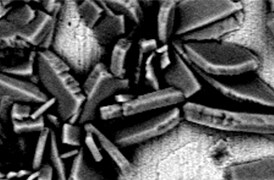
Control de proceso
La industria moderna exige un alto rendimiento con una calidad superior, un equilibrio que se mantiene a través de un control de procesos sólido. Las herramientas SEM y TEM con software de automatización exclusivo proporcionan información rápida y multiescala para la supervisión y la mejora de procesos.
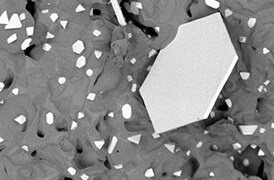
Control de calidad
El control y garantía de calidad son esenciales en la industria moderna. Ofrecemos una gama de herramientas de EM y espectroscopía para el análisis multiescala y multimodal de defectos, lo que le permite tomar decisiones fiables e informadas para el control y la mejora de procesos.
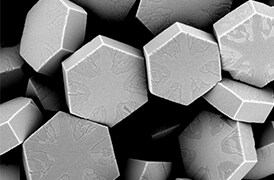
Investigación sobre materiales fundamentales
Se investigan nuevos materiales a escalas cada vez más pequeñas para lograr el máximo control de sus propiedades físicas y químicas. La microscopía electrónica proporciona a los investigadores información clave sobre una amplia variedad de características materiales a escala nanométrica.

Desarrollo y trazabilidad de semiconductores
Microscopía electrónica avanzada, haz de iones enfocado y técnicas analíticas asociadas para identificar soluciones viables y métodos de diseño para la fabricación de dispositivos semiconductores de alto rendimiento.
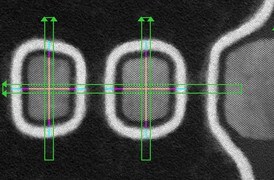
Metrología y rampa de producción
Ofrecemos capacidades analíticas avanzadas para el análisis de defectos, metrología y control de procesos, diseñadas para ayudar a aumentar la productividad y mejorar el rendimiento en una amplia gama de aplicaciones y dispositivos semiconductores.
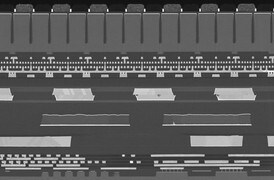
Análisis de fallos de semiconductores
Las estructuras de dispositivos semiconductores cada vez más complejas dan lugar a que existan más ubicaciones en las que se oculten los defectos inducidos por fallos. Nuestros flujos de trabajo de última generación le ayudarán a localizar y caracterizar los sutiles problemas eléctricos que afectan a la producción, al rendimiento y a la fiabilidad.
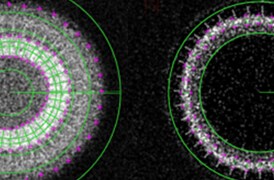
Caracterización física y química
La demanda continua de los consumidores impulsa la creación de dispositivos electrónicos más pequeños, más rápidos y más baratos. Su producción se basa en instrumentos y flujos de trabajo de alta productividad que generan imágenes, analizan y caracterizan una amplia gama de semiconductores y dispositivos de visualización.

Espectroscopia de energía dispersiva
La espectroscopía de energía dispersiva (EDS) recopila información elemental detallada junto con imágenes de microscopía electrónica, proporcionando un contexto de composición esencial para las observaciones de EM. Con EDS, se puede determinar la composición química desde barridos de superficie rápidos y holísticos hasta átomos individuales.

Adquisición de imágenes de muestras calientes
El estudio de los materiales en condiciones reales suele implicar el trabajo a altas temperaturas. El comportamiento de los materiales cuando se recristalizan, derriten, deforman o reaccionan ante el calor se puede estudiar in situ con la microscopía electrónica de barrido o con las herramientas DualBeam.
_Technique_800x375_144DPI.jpg)
SEM ambiental (ESEM)
El SEM ambiental permite que se adquieran imágenes de los materiales en su estado nativo. Esto es ideal para investigadores académicos e industriales que necesitan probar y analizar muestras húmedas, sucias, reactivas, con liberación de gases o que no son compatibles con el vacío.

Experimentación in situ
La observación directa y en tiempo real de los cambios microestructurales con microscopía electrónica es necesaria para comprender los principios subyacentes de los procesos dinámicos como la recristalización, el crecimiento del grano y la transformación de fases durante el calentamiento, refrigeración y humectación.

Análisis de partículas
El análisis de partículas juega un papel vital en la investigación de nanomateriales y el control de calidad. La resolución a escala nanométrica y la adquisición de imágenes superiores de microscopía electrónica se pueden combinar con software especializado para la rápida caracterización de polvos y partículas.

Catodoluminiscencia
La catodoluminiscencia (CL) describe la emisión de luz de un material cuando se excita por un haz de electrones. Esta señal, captada por un detector de CL especializado, contiene información sobre la composición de la muestra, defectos de cristal o propiedades fotónicas.

ColorSEM
Mediante la utilización de EDS en tiempo real (espectroscopia de rayos X por dispersión de energía) con cuantificación en tiempo real, la tecnología ColorSEM transforma las imágenes SEM en una técnica de color. Cualquier usuario puede adquirir datos elementales de forma continua para obtener información más completa que nunca.
Adquisición de imágenes y análisis de semiconductores
Thermo Fisher Scientific ofrece microscopios electrónicos de barrido para todas las funciones de un laboratorio de semiconductores, desde tareas generales de adquisición de imágenes hasta técnicas avanzadas de análisis de fallos que requieren mediciones precisas de contraste de tensión.

Espectroscopia de energía dispersiva
La espectroscopía de energía dispersiva (EDS) recopila información elemental detallada junto con imágenes de microscopía electrónica, proporcionando un contexto de composición esencial para las observaciones de EM. Con EDS, se puede determinar la composición química desde barridos de superficie rápidos y holísticos hasta átomos individuales.

Adquisición de imágenes de muestras calientes
El estudio de los materiales en condiciones reales suele implicar el trabajo a altas temperaturas. El comportamiento de los materiales cuando se recristalizan, derriten, deforman o reaccionan ante el calor se puede estudiar in situ con la microscopía electrónica de barrido o con las herramientas DualBeam.
_Technique_800x375_144DPI.jpg)
SEM ambiental (ESEM)
El SEM ambiental permite que se adquieran imágenes de los materiales en su estado nativo. Esto es ideal para investigadores académicos e industriales que necesitan probar y analizar muestras húmedas, sucias, reactivas, con liberación de gases o que no son compatibles con el vacío.

Experimentación in situ
La observación directa y en tiempo real de los cambios microestructurales con microscopía electrónica es necesaria para comprender los principios subyacentes de los procesos dinámicos como la recristalización, el crecimiento del grano y la transformación de fases durante el calentamiento, refrigeración y humectación.

Análisis de partículas
El análisis de partículas juega un papel vital en la investigación de nanomateriales y el control de calidad. La resolución a escala nanométrica y la adquisición de imágenes superiores de microscopía electrónica se pueden combinar con software especializado para la rápida caracterización de polvos y partículas.

Catodoluminiscencia
La catodoluminiscencia (CL) describe la emisión de luz de un material cuando se excita por un haz de electrones. Esta señal, captada por un detector de CL especializado, contiene información sobre la composición de la muestra, defectos de cristal o propiedades fotónicas.

ColorSEM
Mediante la utilización de EDS en tiempo real (espectroscopia de rayos X por dispersión de energía) con cuantificación en tiempo real, la tecnología ColorSEM transforma las imágenes SEM en una técnica de color. Cualquier usuario puede adquirir datos elementales de forma continua para obtener información más completa que nunca.
Adquisición de imágenes y análisis de semiconductores
Thermo Fisher Scientific ofrece microscopios electrónicos de barrido para todas las funciones de un laboratorio de semiconductores, desde tareas generales de adquisición de imágenes hasta técnicas avanzadas de análisis de fallos que requieren mediciones precisas de contraste de tensión.
Servicios de microscopía electrónica
Para garantizar un rendimiento óptimo del sistema, le proporcionamos acceso a una red de expertos de primer nivel en servicios de campo, asistencia técnica y piezas de repuesto certificadas.











































